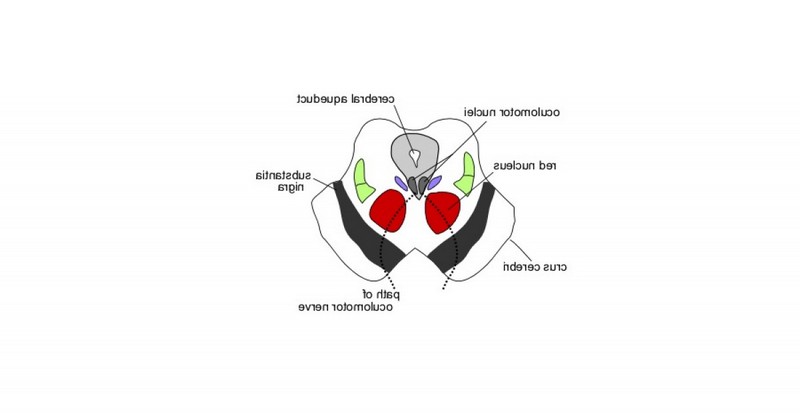Red nucleus (part of the brain): what it is, characteristics and functions.

A part of the midbrain that is linked to the control of certain body movements.
The red nucleus is a very specific structure of the brain, very prominent and movement-related structure of the brain, very prominent, and made up of a large group of nerve cells.
Although some of the functions it performs are known, it is a structure that is still partially unknown and is still under investigation. In this article we will know the most known functions, its characteristics and the affectations that it produces in case of injury.
What is the red nucleus of the brain?
This nucleus is part of the tegmentum. The tegmentum, for its part, is located in another larger area, the midbrain.. And the midbrain, in turn, is part of the brainstem.
Tegmentum
The tegmentum is a brain area located in the brainstem, consisting of 5 structures, including the red nucleusIt consists of 5 structures, including the red nucleus.
Specifically, it is formed by: the periaqueductal gray substance (related to defense behavior and pain inhibition), the ventral tegmental area (related to reinforcement), the red nucleus (related to movement), the Black Substance (also related to movement) and the cerebral peduncles (which coordinate eye movements with the head and neck).
In turn, the red nucleus is divided into two zones: the paleorubrum and the neorubrum.. It has two portions, an inferior magnocellular and an superior parvocellular.
Functions of this part of the encephalon
The red nucleus is involved in the control of Muscle tone, and inhibits muscle contraction responsible for muscle tone.. In addition, it participates in the motor control of the distal arm muscles and proximal leg muscles. On the other hand, it is involved in the motor coordination of the shoulder and upper arm.
Another function of the red nucleus is that it is involved in the crawling of infants when they learn to crawl. It is also is responsible for the swinging movement of the arms when we walk.. Even certain hand movements are also partially controlled by the red nucleus.
On the other hand, the red nucleus acts as a relay center for cerebellar and striatal reflex pathways, and plays an important role in extrapyramidal pathways.and has an important role in cortical extrapyramidal pathways.
In animals
It is known that in animals that do not have a major corticospinal tract (involved in the control of voluntary movements), the red nucleus is involved in their gait. In addition, it is believed that some animals other than humans use this brain structure more. This is due to the fact that the corticospinal tract is more dominant in humans..
Characteristics and anatomy
The color of the red nucleus is a pinkish color that can be seen in fresh brain samples. In addition, as we have seen, it is formed by a large group of cells (a kind of mass).
This mass of cells is located in the mesencephalic tegmentum area of the midbrain, which extends from the substantia nigra.which extends from the substantia nigra (related to dopamine synthesis) to the cerebral aqueduct (containing cerebrospinal fluid). More specifically, it is located dorsal to the substantia nigra. Within it is a rubrospinal tract, which crosses the nucleus itself via axons.
However, although some things are known, much of the function of the red nucleus in humans is unknown.
Related structures
There is another structure related to movement and the red nucleus, the rubrospinal tract (fibers that arise in the red nucleus). This is more specialized in the movement of large muscles (such as the arms), unlike the red nucleus, which has more control over the hands.
Fine psychomotor skills (fine control of the fingers), on the other hand, depend on another related structure, the corticospinal tract, which is related to specific and voluntary movements. The axons of the red nucleus (the majority) do not project to the spinal cord, but do transmit information to the cerebellum. transmit information to the cerebellumThis information comes from the motor cortex.
Injury and disorders linked to it
What happens if the red nucleus of the brain is injured? It could appear a muscular hypertonicity (increase of the muscular tone), originating corporal rigidity.
A lesion in the tegmentum may also include the red nucleus; in these cases, motor skills are altered. Some symptoms that may appear are involuntary tremors, especially in the hands and arms.especially in the hands and arms.
Motor disorders
The lesion of the cerebral areas in charge of controlling, coordinating and managing movements (in addition to the red nucleus), leads to a series of important motor disorders. However, the causes of this type of disorders are very varied and can go beyond what was initially mentioned.
There are two types of motor disorders: pyramidal (involving paralysis) and extrapyramidal (involving difficulties or alterations in the efficiency of movement). At the psychological level, the latter are those that have more to do with the field of neuropsychology.
Extrapyramidal disorders
In extrapyramidal disorders there is an interference in the execution of movements and reflexes.. This may result in a loss of fluency and efficiency in motor activities.
In turn, extrapyramidal disorders can be of three types:
- Rhythmic: tremors.
- Non-rhythmic and stereotyped: tics and stereotypies.
- Non-rhythmic and non-stereotyped: spasms, convulsions, dystonia, dyskinesias, akathisias, etc.
These disorders are related to lesions in certain areas of the brain, such as the basal ganglia.. They are also closely related to dopamine (deficits of this substance) of the neostriatum, and with lesions in the subthalamic nucleus.
Bibliographical references:
- Carlson, N.R. (2005). Physiology of behavior. Madrid: Pearson Educación.
- Del Abril, A; Caminero, AA.; Ambrosio, E.; García, C.; de Blas M.R.; de Pablo, J. (2009) Fundamentos de Psicobiología. Madrid. Sanz y Torres.
- Felten, D.L.; Shetten, A.N. (2010). Netter. Atlas of Neuroscience (2nd edition). Barcelona: Saunders.
- Netter, F. (1989). Nervous system. Anatomy and physiology. Barcelona: Salvat.
(Updated at Apr 14 / 2024)